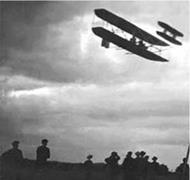Model of a Classical Wing/Tail Configuration
As starting point, one shall assume incompressible, steady, attached flow on the fuselage and the tail. The main wing, of medium to large aspect ratio, either uses the simple linear model presented below, or a more accurate model based on the Prandtl Lifting Line theory. When the latter model is not available, the linear model for the wing is used.
11.2.1 Linear Model for the Main Wing
Consider a rectangular, untwisted wing of span bm and chord cm, equipped with an airfoil of constant relative camber, dm /cm. The wing aspect ratio is ARm — bm/cm. Let a be the geometric incidence, i. e. the angle between the incoming flow vector U and the fuselage axis Ox1 which serves as reference for the angles. The coordinate system attached to the airplane is composed of the (Ox1? Oy^ Oz1) axes, with Ox1 oriented downstream, Oy1 aligned with the right wing and Oz1completing the direct coordinate frame. Accounting for the induced incidence, assumed constant along the span (elliptic loading), and building up on the results from thin airfoil theory, the lift coefficient is given by
|
||
|
||
![]()
tm is the setting angle of the wing on the fuselage. The linear model comprises the lift slope and the a — 0 lift coefficient as
|
||
|
||
|
||
![]()
The reference area for the wing lift is the wing area Am — bmcm. At small incidences, the friction drag is estimated with a flat plate formula
|
2-1R2L, Recm < 5.0 X 105 Recm 20037, Recm > 5.0 X 105 |
|
|
||
|
where Recm is the Reynolds number based on the wing chord. The factor 2 accounts for the two sides of the wing. The reference area for the wing friction drag is Am (Fig. 11.1).
The induced drag is given by the classical formula
Lm
Ж emARm
Fig. 11.1 Wright Flyer III, (from http://wright. nasa. gov/ wilbur. htm)
 em is the wing efficiency or efficiency factor. For a medium aspect ratio wing (AR ~ 10) a value em = 0.9 is acceptable, but values that are higher or even larger than one are possible if winglets are added. The total drag of the main wing is thus
em is the wing efficiency or efficiency factor. For a medium aspect ratio wing (AR ~ 10) a value em = 0.9 is acceptable, but values that are higher or even larger than one are possible if winglets are added. The total drag of the main wing is thus
CDm = CDm0 + CDim.
The moment coefficient of the main wing about the origin of the coordinate system, located at the nose of the airplane, results also from thin airfoil theory as
where Cm, acm — – n dcm is the moment about the aerodynamic center of the wing (function of the mean camber), xacm is the location of the quarter-chord of the wing and cam is the mean aerodynamic chord (here cam — cm). The linear decomposition of the moment reads
dCM, om xacm dCLm „ dm xacm
” = ” j cM, om0 = cLm0 (11.6)
d a cam d a cm cam
The reference “volume” for the wing moment is Amcam











